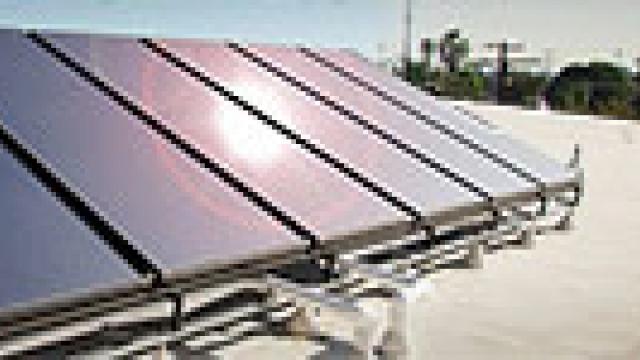We're creating an efficient, clean energy future through our investments in emerging and new technologies that help our customers and our employees use energy more efficiently and productively.
We invest in new and emerging utility operating technologies that can be deployed to increase the productivity of our transmission and distribution operations.
Project Selection Criteria
All investment opportunities are carefully screened to identify those that offer the best potential value to the utility and ratepayers. Project selection criteria include the following:
- Technology concept and potential impact (revolutionary vs. evolutionary)
- Alignment with corporate strategies
- Probability of success
- Fit with SoCalGas’ overall portfolio balance
- Potential for partnering/co-funding, or “leveraging” with others
- Potential to become commercial within three to five years
- Potential for adoption by our customers or our transmission and distribution (T&D) operations
- SoCalGas’ value as a potential strategic partner (e.g., not merely a traditional venture capital investor)
- Positive due diligence, which typically includes a review of the potential partner’s research, development and demonstration (RD&D) strategy, overall business plan, existing and potential stakeholders, management team, intellectual property assets, competitive analysis and projected sales forecast.
- Favorable terms and conditions with a clearly defined SoCalGas® exit strategy.
Green Technology Investments
We invest about $10 million each year on research, development and demonstration of new and emerging clean, energy-efficient technologies. Our goal is to bring these technologies to residential, commercial, industrial, power generation and transportation markets to help reduce their energy use. From residential and clean transportation applications to renewables, here are some examples of projects we've invested in:

Residential Applications
Zero Net-Energy Homes
New homes built will be so efficient that their total energy consumption will be near zero through the use of solar and other technologies.
Natural Gas Heat-Pump Water Heaters
Efficiency and emission mandates drive the need for a natural gas heat-pump water heater. The potential development could lower the cost of ownership for all natural gas options and be retrofitted with most common natural gas storage water heating.
Commercial Food Service
Wok, Wok, Wok
Wok ranges, commonly used in Asian-style restaurants, use a burner system with an efficiency of 10 to 15 percent. SoCalGas developed and demonstrated a new commercial wok range to significantly increase the energy efficiency. Working in conjunction with a popular Asian fast food chain, research entity and manufacturer, the project designed a burner retrofit package. The technology increases the efficiency more than 20 percent, while maintaining the current production level of woks.
Low Oil-Volume Fryer
The low oil-volume fryer reduces operational costs by reducing the required volume of oil used to cook from about 50 pounds for a typical deep fat fryer to about 30 pounds. The technology was licensed to a leading manufacturer to to commercialize the product to customers.
Natural Gas-Fired Warewasher
Working with the Gas Technology Institute and a leading manufacturer to develop and demonstrate a commercial restaurant warewasher using high efficiency burner technology. A field demonstration will be conducted in Southern California to validate performance.
Industrial Applications
Low-Nitrogen Oxides (NOx) Ribbon Burner
Meeting stringent emission requirements without the sacrifice of efficiency, process control or profitability is challenging for industries ranging from food production to material thermoforming. SoCalGas is funding a new development of an advanced low-NOx ribbon burner concept that can provide both cost and environmental benefits in a broad range of agricultural and industrial applications. A demonstration at a Southern California bakery will show this advanced low NOx and fuel-efficient technology which will replace the conventional ribbon burner combustion systems to reduce natural gas use and pollutant emissions in California’s industrial, agriculture and water sectors.
Ultra Low-NOx Boiler
SoCalGas, along with the Gas Technology Institute, and leading manufacturers, will demonstrate an efficient, emerging, ultra low-NOx burner technology, termed Dynamic Staged Entrained burner (DSE). The DSE burner will be installed with a commercial firetube boiler at a linen supply company in Santa Barbara. The DSE burner offers a cost-competitive alternative to currently available equipment for the commercial hot water/steam generation market in California, in an easy to operate and simple design. Extensive laboratory evaluations of the technology under simulated real world conditions have proven the DSE burner is capable of meeting sub 9 ppm NOx levels, while operating with relatively low excess air and high-efficiency levels.
Power Generation and Combined Heat and Power Applications
Combined Heat and Power (CHP) Demonstration
At our data center facility in Monterey Park, we’re demonstrating an innovative CHP Hybrid with uninterruptable power supply (UPS) technology, introduced by the world's leading producer of low-emission microturbine systems. Integrated with a Thermax absorption chiller, the clean-and-green power generated onsite will produce enough electric power to meet the center’s cooling needs in the summer.
FlexCHP Demonstration in Food Processing
With substantial funding support from California Energy Commission (CEC), SoCalGas worked with the Gas Technology Institute and developed a high-efficiency, ultra-clean power and steam package that includes a 65 kilowatt (kW) microturbine and use of an ultra low-NOx, forced internal recirculation burner technology incorporated into a waste heat boiler. Testing at a legume product manufacturer in Riverside demonstrated that the FlexCHP system is capable of meeting CARB 2007 NOx emission requirements for distributed generation systems.
CHP Demonstration in Commercial Greenhouses
CEC and SoCalGas funded the demonstration of a CHP project that includes the installation of three ultra low-emission natural gas-fueled reciprocating engines (total electrical output of 13.2 MW). Waste heat from the engine jacket and exhaust stack is captured and stored in multiple thermal storage tanks, which are used for hydronic heating of the facilities' six greenhouses. The exhaust stack from the engines is combined with that of the facility’s boilers. The exhaust is cooled to ambient temperatures and fed into greenhouses to increase CO2 concentrations for enhanced crop production.
Emission Controls for Rich Burn Engines
In collaboration with the CEC, SoCalGas sponsored a technology development and demonstration program with a next-generation manufacturer of natural gas-fueled, engine-driven CHP products to develop an ultra low emission engine control technology package for a 100 kW CHP engine system. This unique technology that reduces NOx and CO emissions using an advanced catalyst design where engine exhaust is cooled as it flows between catalyst elements. Engine systems have been successfully tested at two CHP sites in Southern California (a community pool and at residential development's community center).
In another program, SoCalGas and CEC-funded leader in fuel control to develop and demonstrate an engine emission control technology based on utilization of advanced electronic gas control valves and use of a NOx sensor for feedback control. The technology has been successfully demonstrated on engines at a wood processing plant in Fontana and at SoCalGas' Honor Rancho facilities.
Clean Transportation Applications (Natural Gas Vehicles)
Near-Zero Emission Heavy-Duty Truck Engines
SoCalGas has been involved with a leading manufacturer of heavy-duty truck engines to meet near-zero emissions specifications, specifically for transit, refuse and drayage vocations. The engines will achieve a 90 percent reduction from the 2010 CARB emission standards in an effort to improve air quality and reduce greenhouse gases throughout the Los Angeles area. This effort will support the Ports of Los Angeles and Long Beach's Clean Air Action Plan. Demonstrations are currently underway and expected to revolutionize the natural gas heavy-duty engine market.
CNG Hybrid Heavy-Duty Drayage Trucks
SoCalGas, with several other entities, is supporting the development and demonstration of several compressed natural gas (CNG) Hybrid Heavy-Duty Drayage Trucks. Drayage trucks are a fundamental component for the heavy-duty goods movement industry as they transport goods from the ports to distribution facilities across the Los Angeles area. These projects aim to reduce greenhouse gas emissions and improve air quality throughout the South Coast Air Basin. The advanced technology incorporates battery-electric drive systems and natural gas engine range extenders to increase performance and operating range for its operators. Demonstrations of these trucks will be primarily concentrated in the I-710 corridor, Port of Los Angeles and Port of Long Beach where considerable amount of class 8 drayage trucks operate year round.
In-Home Refueling
Demonstrating the benefits of using in-home refueling equipment to fill natural gas vehicles (NGVs). SoCalGas has been involved in the testing of a new and improved residential refueling compressor system to alleviate some of the issues in the legacy system. Find out much more about NGVs at our Natural Gas Vehicles home page
Advanced Storage Tanks
SoCalGas is avidly supporting the development of advanced storage tank technologies for higher capacity and a smaller ecological footprint. This will allow NGVs using the advanced storage tanks to have a trunk carrying capacity equivalent to that of their gasoline counterparts, but still the added benefits of using a cheaper and cleaner alternative fuel to gasoline.
Renewables
Biogas Conditioning and Upgrading Technologies Assessment
SoCalGas is funding a study to characterize and evaluate biogas conditioning and upgrading technologies that would allow the injection of upgraded biogas into existing natural gas pipelines that meet the requirements of SoCalGas Rule 30 and AB 1900.
Emissions Control on Biogas-Fueled Engine
SoCalGas and the Eastern Municipal Water District (EMWD) are funding a demonstration of an emission control technology on an engine running on biogas coming from a wastewater treatment facility. The primary goal of the project is to validate compliance with stringent air quality permit limits for NOx and CO that are mandated by the South Coast Air Quality Management District (SCAQMD).
Solar-Thermal Cooling
Solar-thermal cooling uses a simple refrigeration cycle to provide both cool air and hot water from a single unit. The solar-thermal system at SoCalGas includes two types of concentrated solar collectors. One is a parabolic trough and the other is a collection of double-effect, evacuated-tube flat panel plates that produce electricity. The system contains a hot water storage tank, an absorption chiller and a condensing hot water heater. A solar thermal heat pump system will be demonstrated at a large resort and spa in Palm Desert. The system will supplement 100 percent of the facility’s domestic hot water. The current heating equipment will remain in place in a backup role, rendering no operational risk to the facility. At the same time, the system will produce a moderate amount of chilled water, which will help the hotel’s existing chiller use less electricity.

